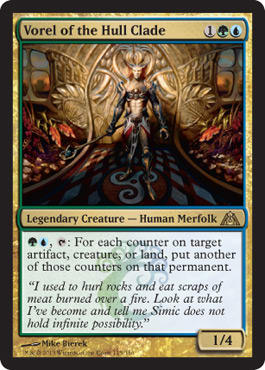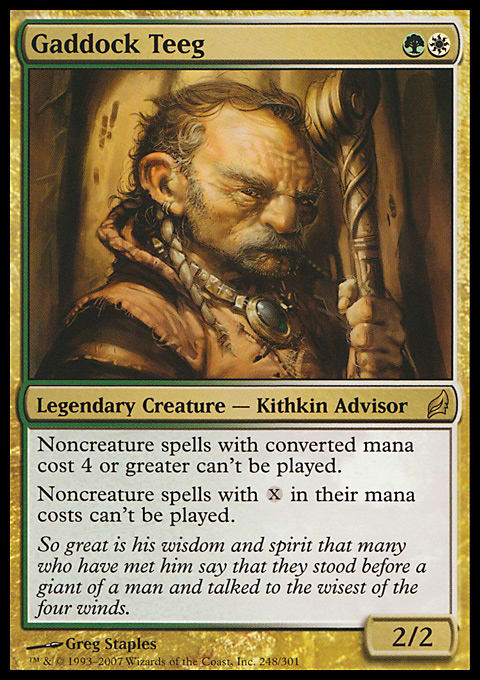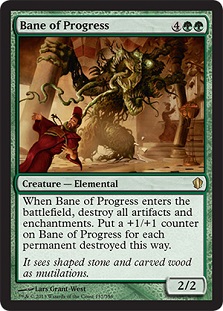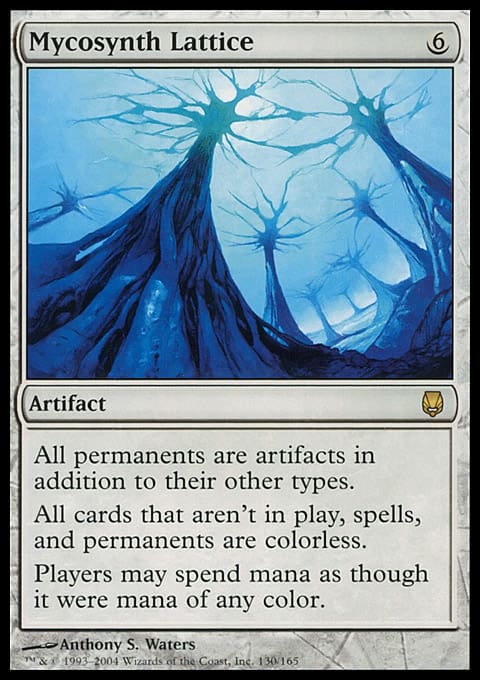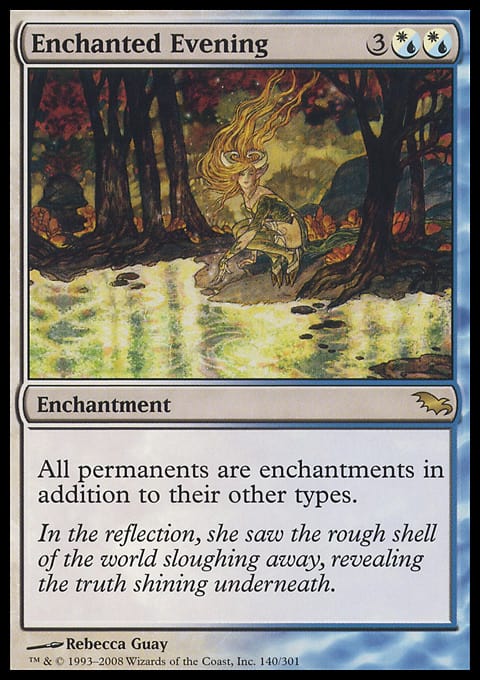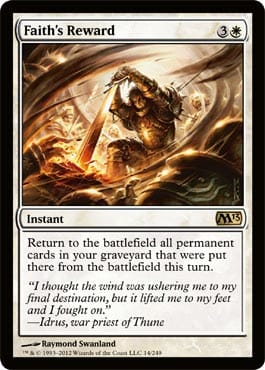After the popular Magic: The Gathering Commander preconstructed decks of 2011, Wizards of the Coast knew they wanted to follow up. Unfortunately, they didn’t have enough time for a full 2012 release of the same caliber, so they rushed to fill the gap with Commander’s Arsenal, a product that was simultaneously desired and hated by most Commander players.
However, the time has come for the next line of WotC’s Commander products with Commander 2013. We’ve already seen five of the new legendary creature cards that headline this year’s decks, and today, previews for the precons begin in earnest. And here at GatheringMagic, I have the honor of sharing with all of you the Elemental that sees shaped stone and carved wood as mutilations and has the superpower to devour them all for its own power.

Now, regular readers of my articles here know that I am a Johnny. That means I like to win with style. I like a challenge. And I like winning with cards no one else wants to use.
Bane of Progress doesn’t really fit the bill at first blush. It seems to be a relatively straightforward Elemental grandpappy to Acidic Slime, which isn’t really known for its Johnny appeal—unless it’s being used with a Deadeye Navigator to destroy all opposing artifacts, enchantments, and lands. And since the Bane doesn’t hit lands, we’re limited to destroying our opponents’ permanents that probably weren’t going to do most of the game-winning work anyway—again, at first blush.
I can think of three broad strokes of ways we can go about playing with Bane of Progress. Let’s take a look.
Play Bane of Progress Fairly
This is the approach many players will take, and it will probably be the approach we see in the Commander 2013 preconstructed deck it’s featured in. (I’ll guess we’ll see the Bane in Marath, Will of the Wild’s Nature of the Beast deck, but who knows?) Basically, playing the Bane fairly means running a normal Commander deck that features artifacts and enchantments of our own. When we play Bane of Progress, we’ll destroy some of our own stuff along with some of our opponents’ stuff, but that just helps ensure we end up with a big Bane.
Since I already mentioned Johnny of the player psychographics, I’ll refer to another one and say that playing Bane of Progress fairly is the Timmy approach. Sure, the Bane might sometimes destroy its controller’s own stuff, but Timmy’s not going to stop playing some of his favorite artifacts and enchantments, is he? Plus, when he does play that Bane of Progress, and it does eat some of his own stuff, it’s going to destroy some of his opponents’ anyway, and it’s going to be huge! Huge, I tell you!
Oh yeah, I should have mentioned that. Even playing Bane of Progress fairly, in a game of Commander, it can end up pretty big. I can imagine this approach resulting in a Commander deck starring such legendary creatures as Jarad, Golgari Lich Lord, Ghave, Guru of Spores, or Vorel of the Hull Clade. All these feature ways to take advantage of a massive Bane and/or its +1/+1 counters.
Play Bane of Progress Unfairly
On the other hand, longtime Commander players may hand-wave massive creatures. Sure, these creatures will close out games every once in a while, but without hexproof, indestructible, or even flying, trample, or haste, the Bane of Progress will often do little more than an Austere Command and perhaps prevent an attack or bait out a Hallowed Burial. And if we had to effectively sacrifice all of our own artifacts and enchantments for that, it’s hardly worth the price of admission.
On the other hand, what if we could generate an almost-as-large Bane without feeding it our own stuff? I’ll call this—to mention the third psychographic—the Spike approach. If we don’t include artifacts or enchantments in our deck, we break the symmetry of Bane of Progress and force our opponents to suffer in its wake. A Spike deck (not the creature type) with Bane of Progress might star Gaddock Teeg or Ruric Thar, the Unbowed. These decks would be built without such frivolities as artifacts and enchantments, and they would punish opposing decks that assumed they were playing a symmetrical game.
Then again, Survival of the Fittest is probably too good for a Spike player to pass up.
Play Bane of Progress Really Unfairly
And here is the Johnny approach. Sure, Bane of Progress can do some work on its own. But if we really want to push it to its limit, it’s going to need some help beyond just a few deck-building choices. No, we need to supply it with some on-the-battlefield effects to make its resolving trigger truly disastrous for our opponents.
Mycosynth Lattice makes every permanent into an artifact, which means Bane of Progress will destroy them all. And it will receive a +1/+1 counter for every one of them—or it would if it weren’t in the graveyard. Since the Lattice makes the Bane an artifact, our Elemental will destroy itself, meaning we virtually just cast a Jokulhaups.
One way to circumvent this is to interrupt the Bane before its triggered ability resolves. For example, we can activate our Asceticism or target the Elemental with a Broken Fall or a Withstand Death. If we want to play on the theme of +1/+1 counters, we can activate our Sporeback Troll to save the Bane. In all of these cases, the battlefield will end up containing solely a massive Bane of Progress, ready to finish off our opponents one at a time . . . starting on our next turn.
Then again, we may not want all of our permanents destroyed. In this case, we can bring in Mycosynth Lattice’s usual pal Darksteel Forge without dipping our toes into other parts of the Magic color pie. For example, consider Glissa Sunseeker headlining a mono-green Commander deck that uses these concepts alongside the Spike approach above. And maybe throw in a Liquimetal Coating.
This combo is essentially the same as with Mycosynth Lattice, but we save 1 mana while dipping into two more colors. Avacyn, Angel of Hope can stand in for Darksteel Forge here unless we use something else to save our Bane—if not our other permanents. Notable on the something-else front is Faith's Reward, which will return all of our own permanents after we destroy everything. Just float mana before Bane of Progress’s enters-the-battlefield ability resolves, and then cast the Magic 2013 instant afterward. Awkwardly enough, the Faith's Reward will return our Enchanted Evening as well as our Bane of Progress, meaning everything will just be destroyed again.
However, the Faith's Reward will return all our lands untapped—before they’re destroyed again—so we can always float mana again, and if there happened to be a Mnemonic Wall or the like involved, we can return our Faith's Reward and repeat over and over again, generating more and more mana each time. And if we controlled a Soul Warden or one of her sisters, we’ll end up with plenty of life, and other enters-the-battlefield abilities, as long as they don’t generate permanents, can create value for us along the way as well. For example, a Mulldrifter will dig us to whatever we need to find through all of our iterations.
However, this is the point at which opponents tend to give up. We will have destroyed all their permanents already, and we just need to demonstrate a way that we’ll be able to keep our own. For this, we just need a way to keep either the Bane of Progress or the Enchanted Evening from reentering the battlefield by way of the Faith's Reward. A simple Memory's Journey or the like will do the job, shuffling whichever piece we choose back into our library before our final Faith's Reward resolves.
And that’s the story of how we turned a creature that says, “Destroy all artifacts and enchantments,” into one that says, “Destroy all permanents.”
Over the past several years, Wizards of the Coast has been making creatures more important to the game in part by granting to creatures effects that have previously been seen on spells. But since creatures are so much more easily recurred, more and more opportunities like this one arise—almost to the point that triggering and retriggering enters-the-battlefield abilities has become tiresome to Johnnies like me. But hey, who doesn’t love a good Flicker now and again?
Before I go, here’s a sixty-card list to demonstrate the premise of the Enchanted Evening combo concepts.
"Bane of the Evening"
- Creatures (20)
- 1 Thragtusk
- 2 Auramancer
- 3 Bane of Progress
- 3 Ondu Giant
- 3 Prophet of Kruphix
- 4 Mnemonic Wall
- 4 Mulldrifter
- Planeswalkers (1)
- 1 Venser, the Sojourner
- Spells (15)
- 1 Memory's Journey
- 3 Faith's Reward
- 4 Aura Blast
- 1 Ethereal Armor
- 2 Sphere of Safety
- 4 Enchanted Evening
- Lands (24)
- 4 Island
- 6 Forest
- 6 Plains
- 4 Glacial Fortress
- 4 Temple of Mystery
Thanks for reading, and be sure to pick up your favorite(s) of the Commander 2013 decks! Just like two years ago, I’m sure there will be a ton of awesome new cards for our hundred-card multiplayer games.
Andrew Wilson
fissionessence at hotmail dot com
















